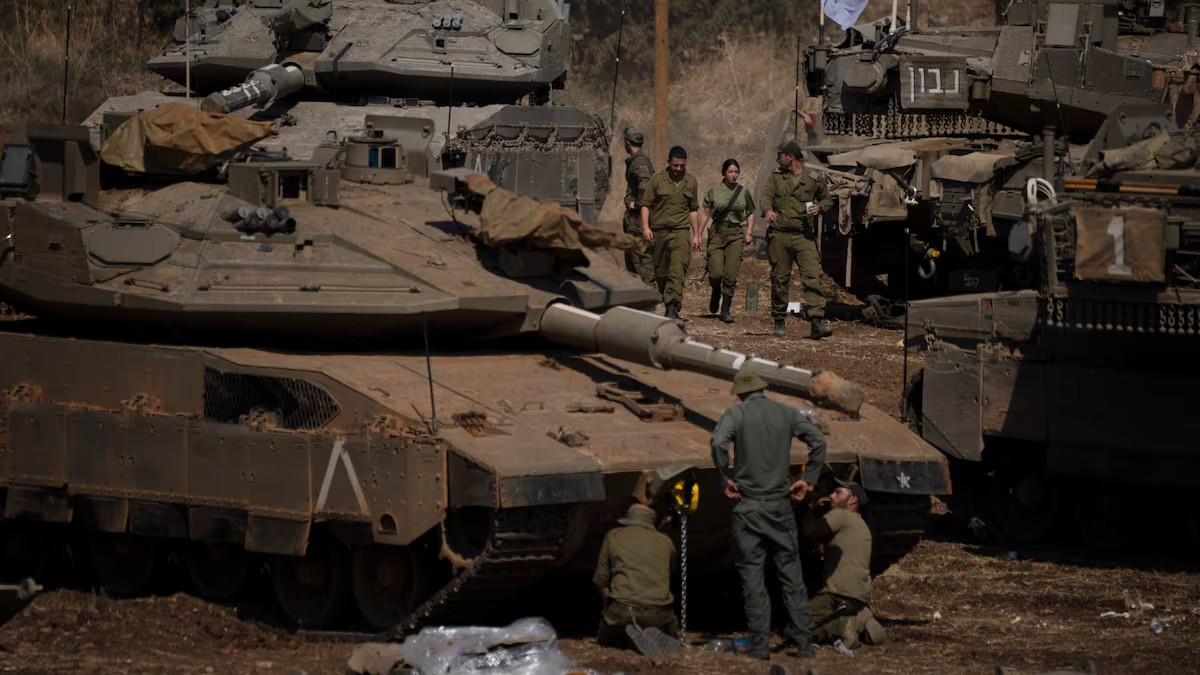
As Benjamin Netanyahu announced in his belligerent speech to the United Nations, Israel is waging a war on “seven fronts,” namely: the genocide in Gaza that is spreading in the form of settler attacks supported by the armed forces in the West Bank. The offensive in Lebanon that began with explosive beepers and had its highest point with the assassination of Hassan Nasrallah, the iconic leader of Hezbollah who enjoyed the prestige of having been the only one capable of defeating Israel in the Lebanon war of 2006. The selective bombings in Iranian territory, where the leader of the political wing of Hamas, I. Haniyeh, was assassinated. And the attacks against the Houthis in Yemen and against pro-Iranian militias in Syria and Iraq. Netanyahu made it clear that the final recipient of these messages is Iran, reminding that there is no place where “the long arm of Israel” does not reach.
Emboldened by the blow he has dealt to Hezbollah, which was left virtually beheaded and for the moment in a state of shock, Netanyahu has redoubled the military bet. As of press time, the Israeli Defense Forces were beginning what appeared to be a limited ground incursion into southern Lebanon. While the bombings continue, which for the first time since the 2006 war, reached the center of Beirut. At this point, districts of the Lebanese capital already look like a sepia postcard of Gaza: incessant bombings against civilian targets, thousands of dead, hundreds of thousands of displaced people, entire families who in their rapid escape ended up sleeping outdoors, in public parks and even on the beach.
This trail of death and destruction in the Middle East carried out by the state of Israel – 42,000 Palestinians killed in Gaza, another 700 in the West Bank, plus a number close to 2,000 in the first bombings in Lebanon – is also Western-made. Despite the enormous international repudiation of the war crimes of the state of Israel, and its growing isolation, Netanyahu has the unconditional support of the United States and European powers such as France and the United Kingdom (to which are added some servants such as Milei ) that provide weapons and diplomatic cover for its genocidal wars. President Joe Biden, the Democratic candidate and current vice president, Kamala Harris, and the Republican candidate Donald Trump, are staunch defenders of the strategic alliance with the Zionist state. And beyond the friction that the White House may have with Netanyahu, “Genocide Joe” considered the murder of Nasrallah as a “measure of justice” and has been religiously complying with the sending of military and financial assistance to Israel, in addition to having reinforced its military presence in the region in the event of an attack by Iran against the Zionist state.
The offensive against Hezbollah-Lebanon, coded as “New Order” by the Israeli commanders, is a tactical success of magnitude for Netanyahu, who had been facing a complicated panorama because after a year of war in Gaza he had not achieved the release of the hostages and even less the “total victory”, that is, the definitive destruction of Hamas. The situation in Israel after the October 2023 Hamas attack is complex. Without a doubt there is a shift to the right in society as a whole. And while the war is popular, Netanyahu’s far-right government is not, questioned above all for its refusal to negotiate a ceasefire in exchange for the release of the dozens of hostages still being held by Hamas. The critical situation of the economy (while Israel attacked Hezbollah, JP Morgan downgraded its credit rating) and the weight of Orthodox sectors and fascist settlers add to Bibi’s unpopularity. However, the new war front brought with it a renewed “national unity” with opponents even more warlike than Netanyahu himself.
The IDF has managed to decapitate Hezbollah in ten days, murdering almost its entire historical political-military leadership. The attack exposed the organization’s vulnerability to infiltration by Israeli intelligence, which was key to finding the exact location of Nasrallah and the senior commanders who accompanied him. And while the Lebanese militia retains a significant missile arsenal and a significant number of fighters, it will probably take some time before it replaces Nasrallah and the murdered military commanders and regains even partial combat capacity.
The IDF has managed to decapitate Hezbollah in ten days, murdering almost its entire historical political-military leadership. The attack exposed the organization’s vulnerability to infiltration by Israeli intelligence, which was key to finding the exact location of Nasrallah and the senior commanders who accompanied him. And while the Lebanese militia retains a significant missile arsenal and a significant number of fighters, it will probably take some time before it replaces Nasrallah and the murdered military commanders and regains even partial combat capacity.
So far, Hezbollah’s “operation decapitation” is undoubtedly a tactical success for Israel and disrupts the regional status quo. But it does not seem enough to establish the ambitious “New Order” to which Netanyahu aspires, which according to the “map of blessing” that he exhibited before the thin audience that heard him at the United Nations Assembly, means erasing the Palestinians from the map. and annex the territories to “Greater Israel,” and perhaps also colonize a strip of southern Lebanon.
More than a “New Order,” the situation seems to be heading towards a leap in regional chaos, which could drag the United States into a new military adventure in the Middle East, in the middle of the dispute for the White House.
In the immediate term, the dynamics will depend largely on how Iran responds, which is faced with a strategic dilemma that is difficult to resolve. The ayatollah regime has been trying by all means to avoid going into a direct confrontation with Israel and by extension with the United States. This strategic priority is responded to by the construction of the defensive axis of militias and tactical and strategic allies, within which Hezbollah has a central role, not only military but as a projection of Iran’s regional political ambitions. Also in that sense was the intervention at the UN by Masoud Pezeshkian, the reformist Iranian president, who with a conciliatory tone sought to resume some dialogue with the United States and the Western powers to achieve relief from sanctions and reestablish negotiations over the nuclear program.
The attack on Hezbollah is a direct attack on the heart of this Iranian strategy. If the regime does not respond, it could give an image of weakness and lose leadership capacity both in the domestic arena, where it has lost legitimacy, and in the international arena. But if he is involved in a war in which he could lose, the result would be just as catastrophic for the survival of the Islamic republic. Faced with a set of bad options, it cannot be ruled out that Supreme Leader Ali Khamenei and in particular the most conservative wing of the Iranian regime will emerge stronger and accelerate the march to develop nuclear weapons.
Taking into consideration the potential turning point that the Israeli escalation of war could mean, some analysts make an analogy with the Six-Day War of 1967, not only because of the military aspect, but above all because the defeat of Nasser and his Syrian partners marked the beginning of the decline of Arab nationalism. Likewise, they consider that it could mean the end of a regional status quo, established fundamentally as a consequence of the defeat of the United States in the war and occupation of Iraq, which had as a collateral effect the regional strengthening of Iran, elevated to the main enemy of the state of Israel.
However, the analogy seems exaggerated, starting with the fact that the blow to Hezbollah, a parastatal militia, continues in the realm of asymmetric warfare. On the other hand, although the Israeli victory in the Six-Day War changed the regional geopolitical equation and led years later to the peace agreement with Egypt, sponsored by North American imperialism, it did not mean the end of the Palestinian national cause, which it survived the betrayal of Arab nationalism and re-emerged in the intifadas of the occupied territories. Which contradictorily was capitalized by Islamist organizations such as Hamas, more radicalized but with the reactionary strategy of establishing a theocratic state.
This is not the first time that Israel has “decapitated” radical Islamist armed organizations. It is actually a fairly common practice. Just to give a few examples, in 1992 he assassinated Abbas Mousavi, then secretary general of Hezbollah who was succeeded by Nasrallah. And in 2004 he executed cleric Ahmed Yassin and Abdel Aziz al-Rantisi, two of the founders of Hamas. It is true that the scale of the current attack is much greater. The war in Gaza has decimated the structure of Hamas and the incursion into Lebanon probably aims to do the same with Hezbollah, in addition to trying to liquidate the will and capacity for resistance of the people through terror, genocide and the threat of extermination. Palestinian (to which Lebanon now joins). In light of historical experience, the tactical advantage of these coups did not end up translating into strategic victories, simply because what Israel and its imperialist allies have not achieved is to liquidate the fight against colonial oppression. On the contrary, they have fueled the radicalization of new generations that recreate resistance in the occupied territories, or face, in the central countries, the complicity of their own governments with the genocide carried out by the state of Israel. Nothing says that this time it will be different.
Source: www.laizquierdadiario.com

